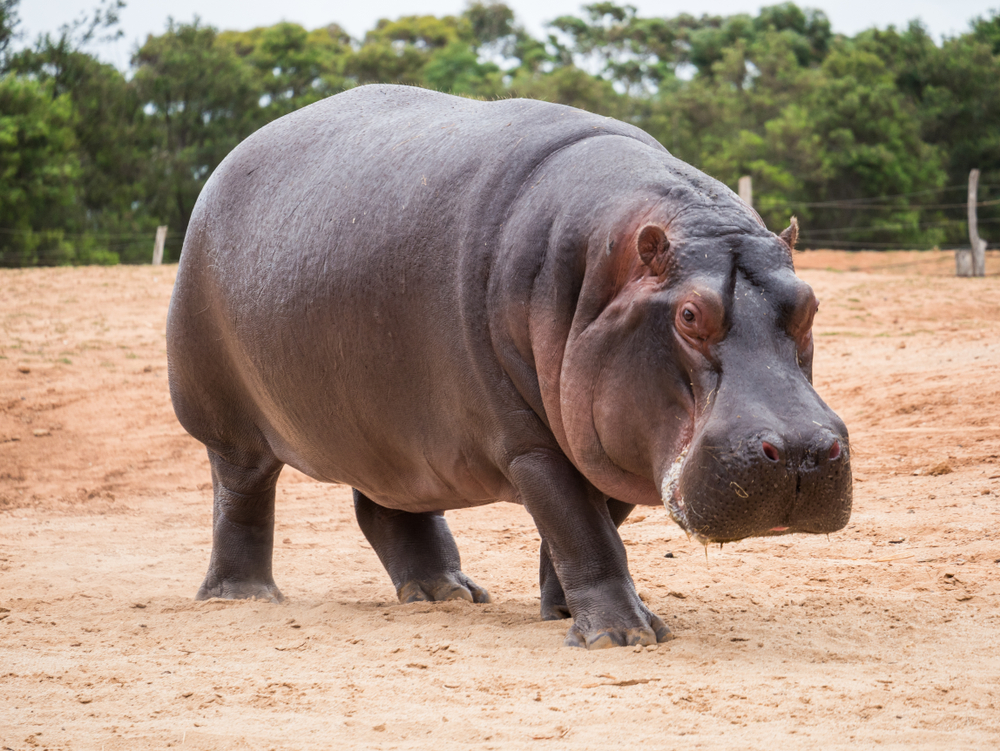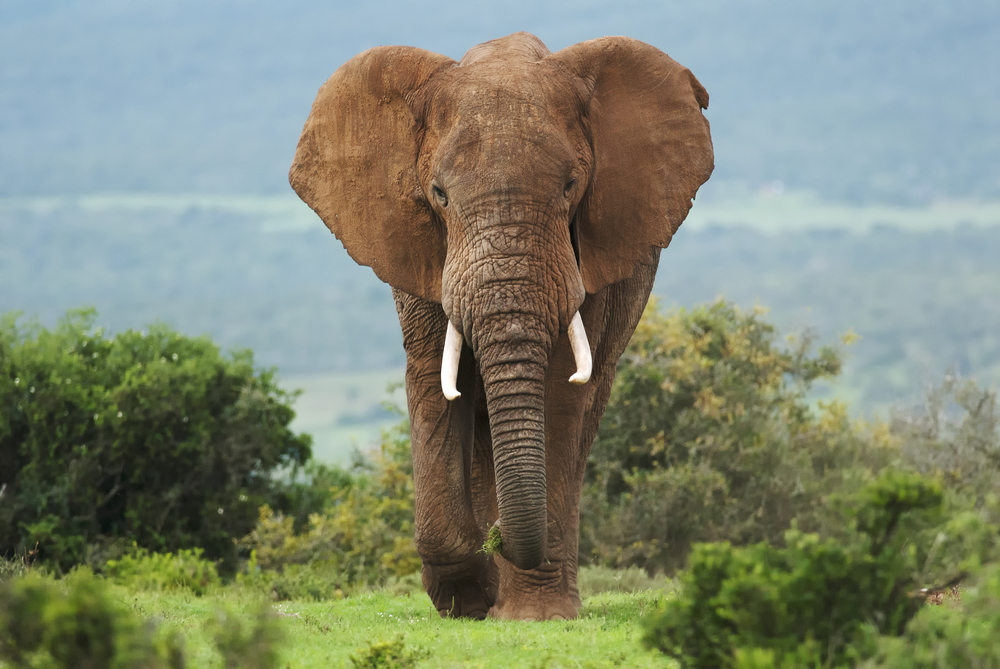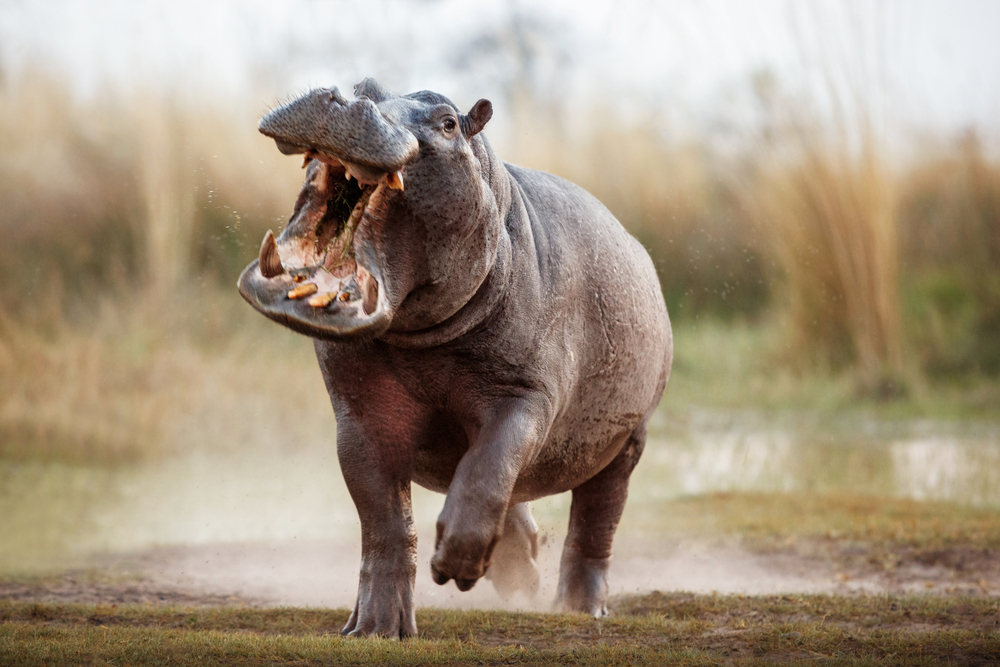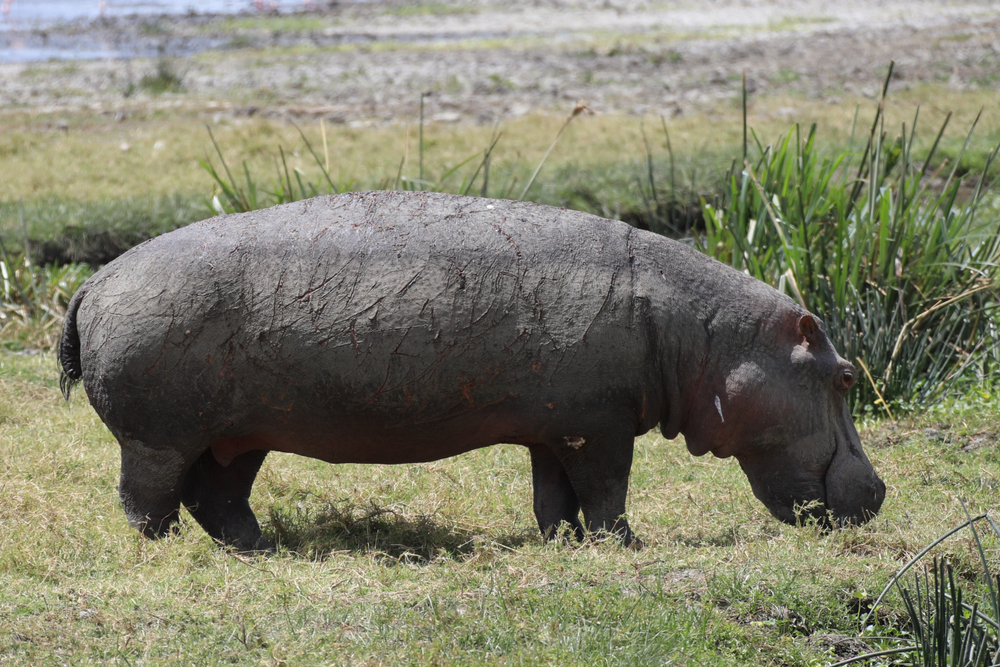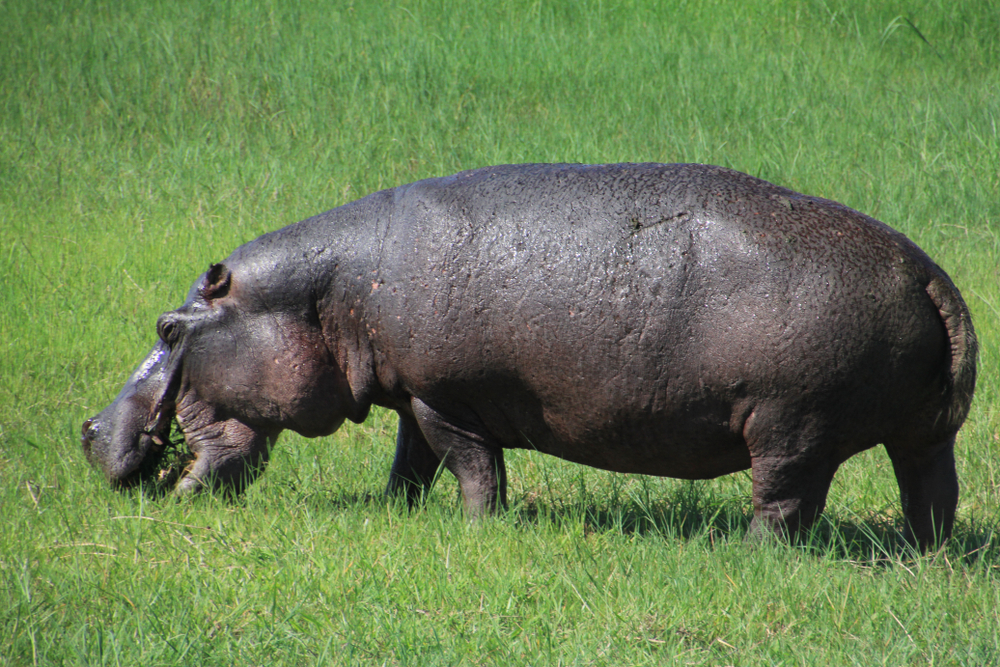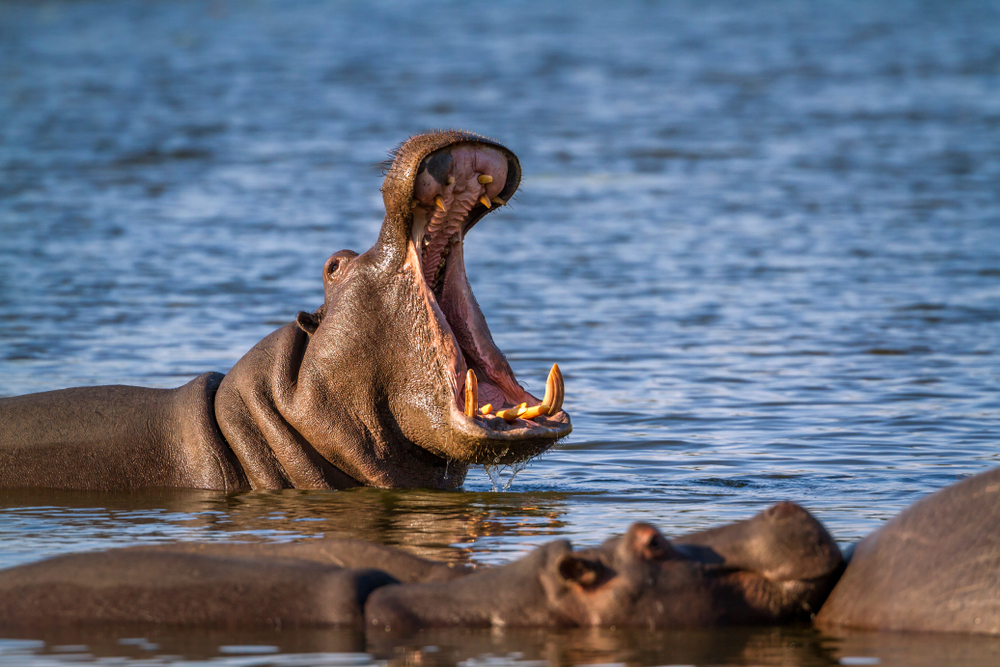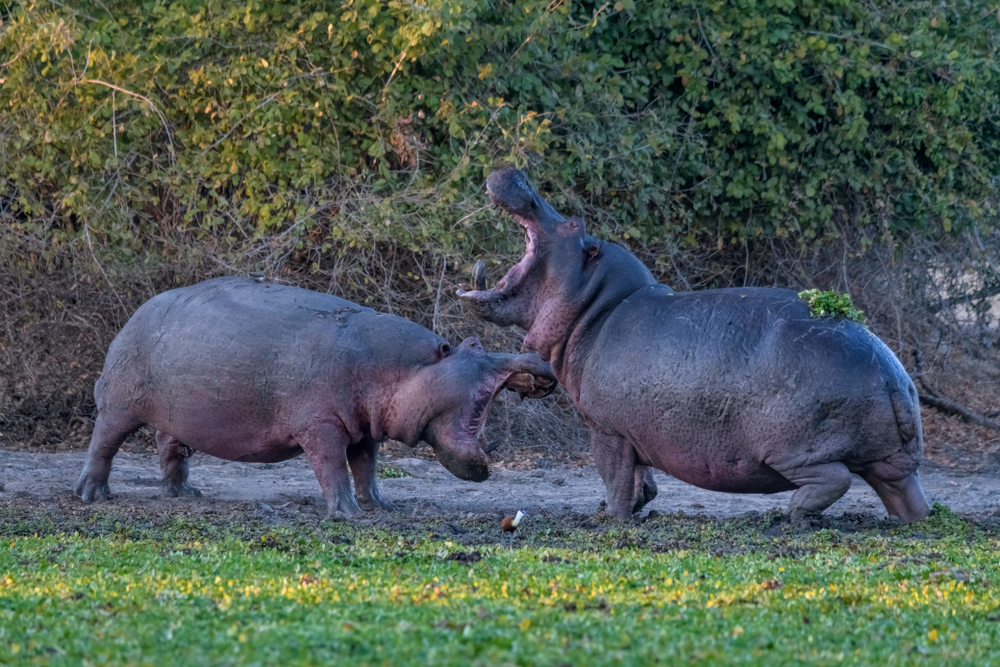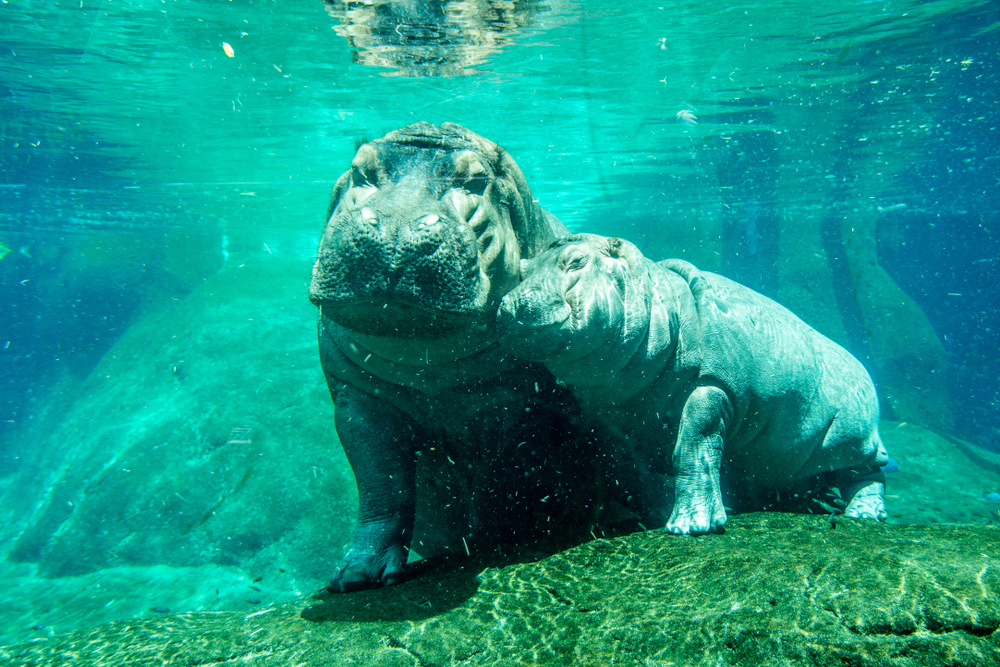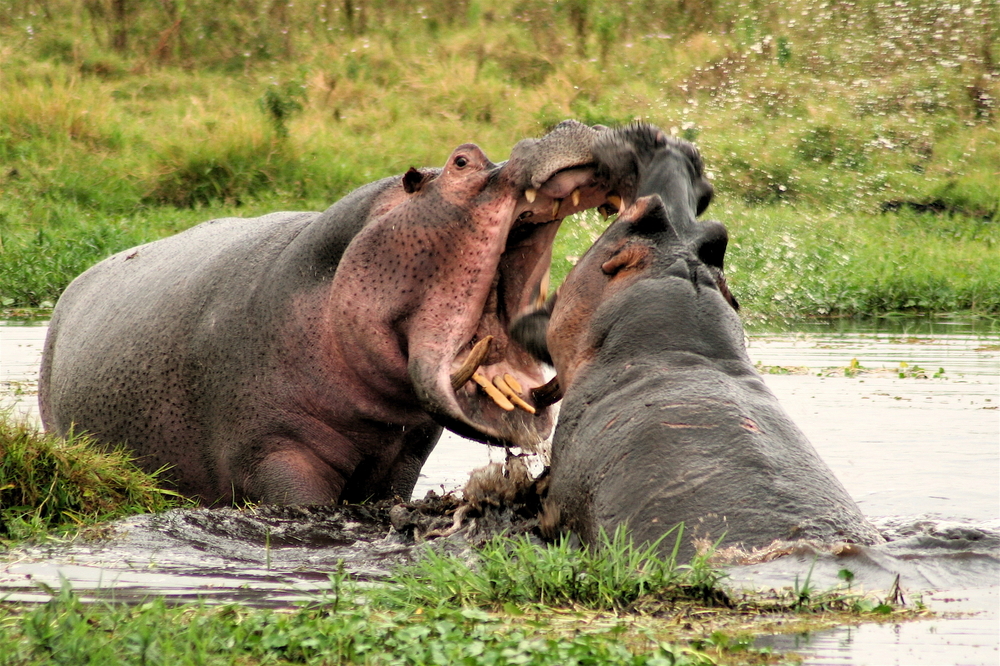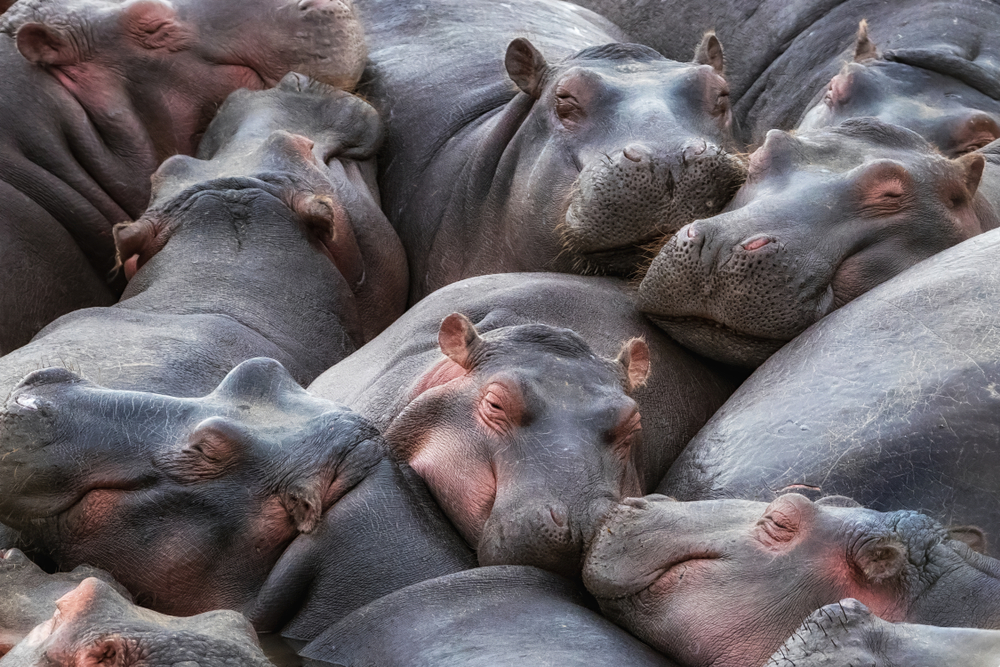Hippopotamuses can hold their breath and stay submerged underwater for about five minutes. However, they often rise to the surface to breathe without waking up or even realizing it, due to their semi-aquatic nature and adaptation to their riverine habitats. This allows them to rest in the water with minimal effort.
About
The Hippopotamus, scientifically known as Hippopotamus amphibius, is a large mammal belonging to the Animal Kingdom’s phylum Chordata and class Mammalia. It is a member of the Hippopotamidae family, which also includes the pygmy hippopotamus (Choeropsis liberiensis). Hippos are semi-aquatic herbivores native to sub-Saharan Africa, inhabiting rivers, lakes, and swamps.
These massive animals are characterized by their barrel-shaped bodies, large heads, and short legs. They have thick, hairless skin that is typically grayish-brown in color, which secretes a pinkish oil that helps protect their skin from drying out. Hippos spend much of their time submerged in water to keep cool and avoid the sun’s heat, emerging at night to graze on grasses and other vegetation.
Despite their seemingly sluggish appearance, hippos are surprisingly agile and can move quickly both on land and in water. They are known for their territorial behavior and can be highly aggressive, particularly during the mating season or when defending their territories or offspring.
Conservation Concerns
The International Union for Conservation of Nature (IUCN) Red List categorizes the Hippopotamus as vulnerable due to habitat loss, poaching, and human-wildlife conflict. Hippos face threats from habitat degradation caused by agriculture, logging, and infrastructure development, which fragment their habitats and limit access to water sources.
Additionally, hippos are hunted for their meat, ivory-like teeth, and other body parts, leading to population declines in some regions. Human encroachment into hippo habitats also increases the risk of conflicts between humans and hippos, resulting in retaliatory killings and further population declines.
Conservation efforts aimed at protecting hippo habitats, reducing human-wildlife conflicts, and implementing sustainable hunting practices are crucial for the long-term survival of hippopotamus populations. Continued monitoring and conservation initiatives are essential for maintaining healthy ecosystems where hippos play a vital role as grazers and ecosystem engineers.
Physical Characteristics
The hippopotamus, or hippo, is a large, mostly herbivorous mammal native to sub-Saharan Africa, and is one of the most recognizable animals in the world due to its distinctive shape and size. Here is a detailed overview of the physical characteristics of the hippopotamus:
Size
- Body Length: Hippos typically measure between 10.8 to 16.5 feet (3.3 to 5 meters) in length.
- Height: At the shoulder, they stand about 4.9 to 5.9 feet (1.5 to 1.8 meters) tall.
- Weight: Adult hippos can weigh between 2,870 to 3,300 pounds (1,300 to 1,500 kilograms) for females and up to 3,310 to 4,410 pounds (1,500 to 2,000 kilograms) for males, with exceptionally large males reaching weights of up to 9,920 pounds (4,500 kilograms).
Physical Characteristics
- Skin: One of the most notable features of the hippopotamus is its thick, hairless skin, which is a grayish-brown color and can secrete a natural sunscreen that appears red or pink. This secretion is often referred to as “blood sweat,” although it is neither blood nor sweat.
- Mouth and Teeth: Hippos are well-known for their large mouths and enormous teeth. Their mouths can open to an impressive 150 degrees wide. They have large canine teeth and incisors, which are used in fights and as a display to rivals. The canines and lower incisors grow continuously, with canines reaching up to 20 inches (51 centimeters) in length.
- Eyes, Ears, and Nostrils: These are located high on their heads, allowing hippos to breathe and look around while mostly submerged in water. Their ears and nostrils can close to protect against water entry when submerged.
- Legs and Feet: Despite their massive size and bulky appearance, hippos have relatively short, sturdy legs with four webbed toes on each foot. This webbing aids them in swimming and moving through water, where they spend much of their time.
- Tail: They have a short tail, tipped with a small tuft of hair, which they wag to spread their excrement to mark their territory.
Behavior and Adaptations
- Aquatic Life: Hippos are highly adapted to a life spent mostly in the water. Their specific gravity allows them to sink and walk on the bottom of rivers and lakes. They can hold their breath underwater for up to five minutes.
- Thermoregulation: The hippo’s large size and skin secretion help regulate its body temperature, keeping it cool under the hot African sun.
- Diet: Although they are primarily nocturnal grazers, feeding on grasses, the physical build of their mouth and the tough grinding molars reflect their herbivorous diet.
Hippos play a crucial role in their ecosystem by impacting the environment around rivers and lakes and providing pathways for other animals through dense vegetation. Their physical attributes, combined with their semi-aquatic lifestyle, make them a unique and integral part of the African wildlife landscape.
Reprodction
The reproductive cycle of the Hippopotamus, or hippo, is fascinating and influenced by various factors. Here’s an overview:
Breeding Season: Hippopotamuses do not have a distinct breeding season, and mating can occur throughout the year. However, there may be peaks in mating activity during certain periods, often coinciding with favorable environmental conditions and resource availability.
Courtship and Mating: Mating behavior in hippos involves courtship rituals and displays, primarily conducted by males to attract females. These rituals can include vocalizations, posturing, and physical interactions such as chasing or fighting with rival males. Dominant males establish territories and compete for access to females.
Gestation Period: After successful mating, female hippos undergo a gestation period of approximately 8 months. During this time, the developing fetus grows inside the mother’s womb, receiving nourishment and protection until birth.
Birth and Calving: Hippo calves are usually born in the water, where the mother provides assistance during the birthing process. Calves are typically born singly, although twins can occur infrequently. The newborn calf is immediately able to swim and follow its mother, relying on her for protection and nourishment.
Maternal Care: Female hippos are devoted mothers, nurturing and protecting their calves from potential threats in their aquatic environment. Calves remain close to their mothers, nursing regularly and learning essential survival skills, including swimming and foraging.
Weaning and Independence: Hippo calves are weaned gradually over several months but may continue to nurse for up to a year or longer. During this time, they learn to feed on aquatic vegetation and develop independence, eventually venturing out on their own.
Maturity and Reproductive Success: Hippopotamuses reach sexual maturity at around 5-7 years of age, although males may not establish dominance and successfully mate until they are older. Reproductive success is influenced by factors such as social dynamics, habitat quality, and individual health.
Population Dynamics and Conservation: Hippopotamus populations face various threats, including habitat loss, poaching, and human-wildlife conflict. Understanding the reproductive cycle and behavior of hippos is crucial for effective conservation efforts aimed at ensuring their long-term survival and maintaining healthy populations in their natural habitats.
Lifespan
Eating Habits
The hippopotamus, often referred to as the “river horse,” is a large semi-aquatic mammal native to sub-Saharan Africa. Understanding its eating habits sheds light on its role as a herbivore and its unique feeding adaptations. Let’s explore the feeding habits of the hippopotamus.
Diet: Hippopotamuses are herbivores, primarily feeding on vegetation. Their diet typically includes:
- Grasses: Grass makes up the bulk of a hippopotamus’s diet. They consume a variety of grass species found along riverbanks, lakeshores, and other water bodies.
- Aquatic Plants: In addition to grass, hippopotamuses also feed on a variety of aquatic plants such as water hyacinth, water lettuce, and reeds. These plants grow in and around water bodies and provide an additional food source for hippos.
Feeding Behavior: Hippopotamuses exhibit several feeding behaviors to obtain their food:
- Nocturnal Feeding: Hippos are primarily nocturnal feeders, venturing out of the water at night to graze on grasslands adjacent to rivers and lakes. This behavior helps them avoid the heat of the day and reduces the risk of predation.
- Browsing: While feeding, hippos use their wide mouths and powerful jaws to grasp and tear vegetation. They can consume large quantities of grass in a single feeding session, using their lips and tongues to manipulate the vegetation.
- Submerged Feeding: Despite their large size, hippos are surprisingly agile in the water. They can hold their breath for several minutes and feed on aquatic plants while submerged. This allows them to access a diverse range of food sources.
Dietary Adaptations:
- Hippos have large, blunt teeth adapted for grinding tough vegetation. Their molars are well-suited for processing fibrous plant material.
- The semi-aquatic lifestyle of hippos allows them to access both terrestrial and aquatic vegetation, giving them a diverse diet.
Conservation Concerns:
- Habitat loss and degradation threaten hippopotamus populations as human activities encroach upon their natural habitats. Deforestation, agriculture, and urbanization reduce the availability of suitable grazing areas for hippos.
- Human-wildlife conflict poses another significant threat, as hippos may raid crops near water bodies, leading to conflicts with local communities. Implementing conservation strategies that focus on habitat protection and mitigating human-wildlife conflicts are crucial for the long-term survival of hippopotamus populations.
Uniqueness
The Hippopotamus, scientifically known as Hippopotamus amphibius, is a large, mostly herbivorous mammal native to sub-Saharan Africa, recognized for its unique adaptations to a semi-aquatic lifestyle. Here are some key aspects that make the Hippopotamus unique:
Massive Size and Density: Hippos are among the largest land mammals, only smaller in size than elephants and some rhinos. Adult males can weigh up to 1,500 to 1,800 kg (3,300 to 4,000 lbs), with females slightly smaller. Their bodies are barrel-shaped, with an almost hairless, thick skin that adds to their bulk and provides protection.
Aquatic Adaptations: Despite their great mass, hippos are well-adapted to aquatic life. Their eyes, ears, and nostrils are positioned on top of their heads, allowing them to see, hear, and breathe while mostly submerged. Their specific gravity allows them to sink and walk or run along the bottom of rivers and lakes, where they spend most of their day to keep cool and avoid sunburn.
Territorial in Water: Hippos are highly territorial in water, where males vigorously defend stretches of river or lakeshores as their own, particularly during the breeding season. These territories are central to a male’s mating opportunities and are defended against rivals through displays of yawning (showing their large teeth) and combat.
Diet and Grazing Habits: Although hippos spend much of their time in water, they are primarily grazers, feeding on grass during the night. They can consume about 40 kg (88 lbs) of grass each night, traveling several kilometers to find sufficient food.
Unique Skin Secretion: Hippo skin secretes a natural sunscreen substance that is red-colored, which often leads to the myth that they sweat blood. This secretion is actually a skin moistener and sunblock that may also provide some antimicrobial protection.
Social Behavior: Hippos form groups called pods, which can consist of 10 to 30 individuals, mostly females and their young, with a few subordinate males. The dominant male generally controls the pod and the territory within a water body.
Reproduction and Development: Female hippos give birth approximately every two years, usually to a single calf which can weigh about 50 kg (110 lbs) at birth. Births occur in water, with the mother isolating herself from the pod; the calf must swim to the surface to take its first breath.
Impact on Ecosystem: Hippos play a significant ecological role in their habitats. They serve as major consumers of vegetation, helping to shape the landscape and prevent overgrowth. Their paths through vegetation create channels that other animals use, and their dung enriches aquatic ecosystems, although it can also contribute to fish kills by depleting oxygen levels.
Conservation Status: While not currently endangered, hippos face threats from habitat loss and illegal hunting for their meat and ivory (found in their teeth). They are also considered dangerous to humans and are responsible for many deaths in Africa each year, complicating their coexistence with local communities.
The Hippopotamus’ combination of terrestrial and aquatic life, massive size, unique physiological traits, and significant impact on its ecosystem make it a truly unique and vital species within its African habitat.
FAQ’s
1. How long can the hippopotamus stay under water?
2. Why are hippopotamuses considered so dangerous?
Hippopotamuses are considered one of the most dangerous animals in Africa for several reasons:
- Territoriality: Hippos are extremely territorial, especially in water. They can become very aggressive if they feel threatened or if their territory is encroached upon. This can be particularly hazardous for people who unknowingly enter hippo territories while navigating rivers or lakes.
- Unpredictability: Despite their slow appearance on land, hippos can be unpredictable and can charge with little warning. They can run at speeds of up to 30 km/h (19 mph), which is surprisingly fast for such large animals.
- Powerful Jaws: Hippos have one of the most powerful bites in the animal kingdom. Their large mouths can open up to 150 degrees and have massive jaws capable of snapping a canoe in half or causing significant harm to other animals or humans.
- Size and Strength: Their sheer size and strength make them formidable. An adult male can weigh between 1,500 to 1,800 kilograms (3,300 to 4,000 pounds), and they use their bulk to assert dominance and during fights.
- Aggression During Mating Season: Male hippos are particularly aggressive during the mating season as they compete over females. This heightened aggression can pose additional risks.
- Protection of Young: Female hippos are also known to be very protective of their calves and can be aggressive if they sense a threat to their offspring.
- Coexistence with Humans: In many areas of Africa, humans and hippos share the same space, leading to conflicts. Hippos may raid crops and, in doing so, come into conflict with farmers. Additionally, fishermen and others who rely on waterways for transportation and livelihood can inadvertently provoke hippos.
Due to these factors, hippos are responsible for more human fatalities in Africa than any other large animal. Their dangerous reputation is a reminder of the respect and caution that must be maintained when sharing habitats with wildlife.
3. How fast can a hippopotamus run?
Hippopotamuses can reach speeds of up to 30 kilometers per hour (19 miles per hour) on land over short distances. Despite their large size and heavy build, they are surprisingly quick and agile, which adds to their reputation as one of the most dangerous animals in Africa.
4. How fast can a hippopotamus swim?
Hippopotamuses are not known for their speed in swimming like they are for their surprising bursts of speed on land. They are more adept at walking or trotting along the riverbed or lake bottom, where they push off from the bottom to move through the water. When they do swim, they do so gracefully, but their exact speed while swimming is not well-documented.
Their movement in water is more about buoyancy and maneuverability than speed. They are capable of propelling themselves in a sort of gallop along the bottom rather than swimming in the traditional sense, using their webbed feet to steer and push off the ground.
Related Family Species
Sources
- Alden, Peter et al, National Audubon Society Field Guide to African Wildlife, New York, NY.
- Burnie, David & Wilson, Don, Animal, Smithsonian Institute, Washington DC.
- Clutton-Brock, Juliet and Wilson, Don, Mammals, Smithsonian Handbooks, New York, NY.
- Hickman et al, Integrated Principle of Zoology, McGraw Hill, Boston.
- Nolting, Mark, Africa’s Top Wildlife Countries, Global Travel Publishers, Inc., Ft. Laurderdale, FL.
- Paragon, The Ultimate Guide to Wildlife in North America, Atlantic Publishing, UK.






























































